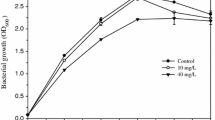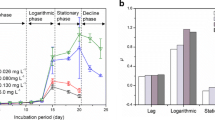Abstract
A novel system combining acoustic wave impedance (AWI) analyzer with UV-vis spectrophotometer was developed for the study of chromium (VI) reduction kinetics by Pseudomonas aeruginosa. AWI gave information about the growth of Pseudomonas aeruginosa, and UV-vis spectrophotometer gave information about the concentration of chromium (VI) simultaneously. A combined system response model, for chromium (VI) reduction kinetics at lower initial chromium (VI) concentrations, was derived and proved based on the novel system. Taking into account the effect of bacterial growth on chromium (VI) reduction, the new model successfully simulated chromium (VI) bioremediation process. By fitting chromium (VI) reduction data toward the derived model, the kinetic parameters related to the process were obtained. When the concentration of peptone was 10 g L−1, the half-velocity reduction rate constant K C and the maximum specific chromium (VI) reduction rate constant νmax were 0.7682 mg chromium (VI) L−1 and 2.5814 × 10−12 mg chromium (VI) cells−1 h−1, respectively. It was found that the combined system can provide real-time, reliable, and two-dimensional kinetic information, and can be applied to study other biological processes.





Similar content being viewed by others
Literature Cited
Bartlett RJ, Kimble JM (1976) Behavior of chromium in Soils: II. Hexavalent Forms. J Environ Qual 5:383–386
Cheung KH, Gu JD (2002) Bacterial color response to hexavalent chromium, Cr6+. J Microbiol 40:234–236
Clesceri LS, Greenberg AE, Trussel RR (1989) Standard methods for the examination of water and waste water, 17th edn. Washington DC: American Public Health Association
Gompertz B (1825) On the nature of the function expressive of the law of human mortality and on a new mode of determining the value of life contingencies. Phil Trans R Soc London 115:513–585
Guha H, Jayachandran K, Maurrasse F (2001) Kinetics of chromium (VI) reduction by a type strain Shewanella alga under different growth conditions. Environ Pollut 115:209–218
Hayes RB (1997) The carcinogenicity of metals in humans. Cancer Causes Control 8:371–385
Megharaj M, Avudainayagam S, Naidu R (2003) Toxicity of hexavalent chromium and its reduction by bacteria isolated from soil contaminated with tannery waste. Curr Microbiol 47:51–54
Monod J (1949) The growth of bacterial cultures. Annu Rev Microbiol 3:371–394
Muramatsu H, Tamiya E, Karube I (1988) Computation of equivalent circuit parameters of quartz crystals in contact with liquids and study of liquid properties. Anal Chem 60:2142–2146
Patterspn JW (1985) Industrial wastewater treatment technology. Stoneham, MA: Butterworth Publication
Ryan MP, Williams DE, Chater RJ, Hutton BM, McPhail DS (2002) Why stainless steel corrodes. Nature (London) 415:770–774
Smith WL, Gadd GM (2000) Reduction and precipitation of chromate by mixed culture sulphate reducing bacterial biofilm. J Appl Microbiol 88:983–991
Stearns DM, Belbruno JJ, Wetterhahn KE (1995) A Prediction of chromium (III) Accumulation in humans from chromium dietary supplements. FASEB J 9:1650–1657
Tao H, Wei WZ, Zhang SF (2004) Photo catalytic inhibitory effect of immobilized TiO2 semiconductor on the growth of Escherichia coli studied by acoustic wave impedance analysis. J Photoch Photobio A 161:193–199
Wang YT, Shen H (1997) Modeling chromium (VI) reduction by pure bacterial cultures. Water Res 31:727–732
Yamamoto K, Kato J, Yano T, Ohtake H (1993) Kinetics and modeling of hexavalent chromium reduction in Enterobacter cloace. Biotechnol Bioeng 41:129–133
Zhang JZ, Wei WZ, Mao YA, Chai LY (2001) Monitoring of bio-oxidation process of ferrous ion by using piezoelectric impedance analysis. Curr Microbiol 43:83–88
Acknowledgments
The authors gratefully acknowledge the financial support of Special Research Found for the Doctoral Program of Higher Education and the Human Provincial, Natural Science Foundation of China (No. 05JJ20011).
Author information
Authors and Affiliations
Corresponding author
Rights and permissions
About this article
Cite this article
Li, X., Wei, W., Zeng, X. et al. Study on Chromium (VI) Reduction Kinetics by Pseudomonas aeruginosa Using a Combined System of Acoustic Wave Impedance Analyzer and UV-Vis Spectrophotometer. Curr Microbiol 53, 249–254 (2006). https://doi.org/10.1007/s00284-006-0123-5
Received:
Accepted:
Published:
Issue Date:
DOI: https://doi.org/10.1007/s00284-006-0123-5




